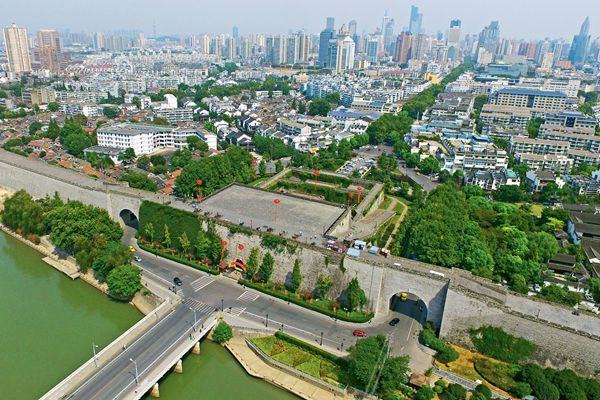Nanjing:city of memories
 0 Comment(s)
0 Comment(s) Print
Print E-mail China Today, January 19, 2017
E-mail China Today, January 19, 2017
Home of Talents
Nanjing has a tradition of reverence for culture and education, and so has the reputation for being a "center of culture under heaven."
The first Imperial College in Nanjing was established way back in the third century. The Six Dynasties period saw the establishment of schools specifically for teaching Confucianism, metaphysics, literature, and history.
|
An aerial view of Zhonghuamen Gate in the Ming City Wall, Nanjing. |
During the Ming Dynasty, the Guozijian (or the Imperial Academy), the highest institution of learning of that time, was established in Nanjing. It was generally assumed that those who could enter Guozijian would become virtuous and knowledgeable, and hence useful and important to the state.
Jiangnan Examination Hall, which has the capacity for 20,000 examinees at one time, was the largest of its kind in ancient China. It was used to host provincial and national level examinations for students from Jiangsu and neighboring Anhui Province.
During the Ming and Qing dynasties, half the candidates for all sessions of the national examinations came from the Jiangnan Examination Hall. Among them were Tang Bohu, one of the "four literary masters of the Jiangnan region;" Wu Cheng'en, author of Journey to the West; Wu Jingzi, author of the novella The Scholars (Rulinwaishi); Zheng Banqiao, painter and one of "eight eccentric painters of Yangzhou;" and Chen Duxiu, a forerunner of the modern democratic movement.
Nanjing is the birthplace of Cao Xueqin (c.1715-c.1763), author of A Dream of Red Mansions, which is regarded one of the greatest works of Chinese literature. As his clan had held the office of Imperial Textile Commissioner in Jiangning (another name of Nanjing) for three generations, Cao's childhood was well-to-do and carefree.
However, as family fortunes declined, Cao moved with his family to Beijing. This loss of status and the suffering it brought to each family member is reflected in Cao's masterpiece A Dream of Red Mansions.
The voluminous novel, known, admired, and enjoyed throughout the world, is generally acknowledged as the epitome of Chinese literary excellence.
The Compendium of Materia Medica, (Bencao Gangmu) was written by Li Shizhen (1518-1593) during the Ming Dynasty and first published in Nanjing. Li spent almost 30 years on the first draft of the book, which detailed all known medical knowledge and experience. It recorded 1,095 herbal remedies, accounting for 58 percent of all known medicines.
In 1590, it was finally printed and published in Nanjing, 12 years after Li completed the book. Widely acclaimed, it has been reprinted countless times.
The Yongle Encyclopedia (known as Yongle Dadian in Chinese), the largest of its kind in ancient China, was also compiled and completed in Nanjing. A massive collection of works embracing Chinese science and culture in its entirety, the work consists of 22,937 manuscript scrolls in 11,095 volumes that bear around 370 million Chinese characters.
Most copies of the Yongle Encyclopedia were stolen or destroyed during years of wars and social turbulence, and today only around 800 scrolls of the original manuscript are preserved around the world.
The prominent Chinese mathematician and astronomer Zu Chongzhi (429-500) was also born in Nanjing. He was the first to calculate the sixth and seventh decimal places of Pi from 3.14159 to 3.1415927. The accuracy of Zu's estimate remained unsurpassed until the Persian Astronomer and mathematician Al-Kshn (1380-1429) took Pi to the 16th decimal place about 1,000 years later.







Go to Forum >>0 Comment(s)